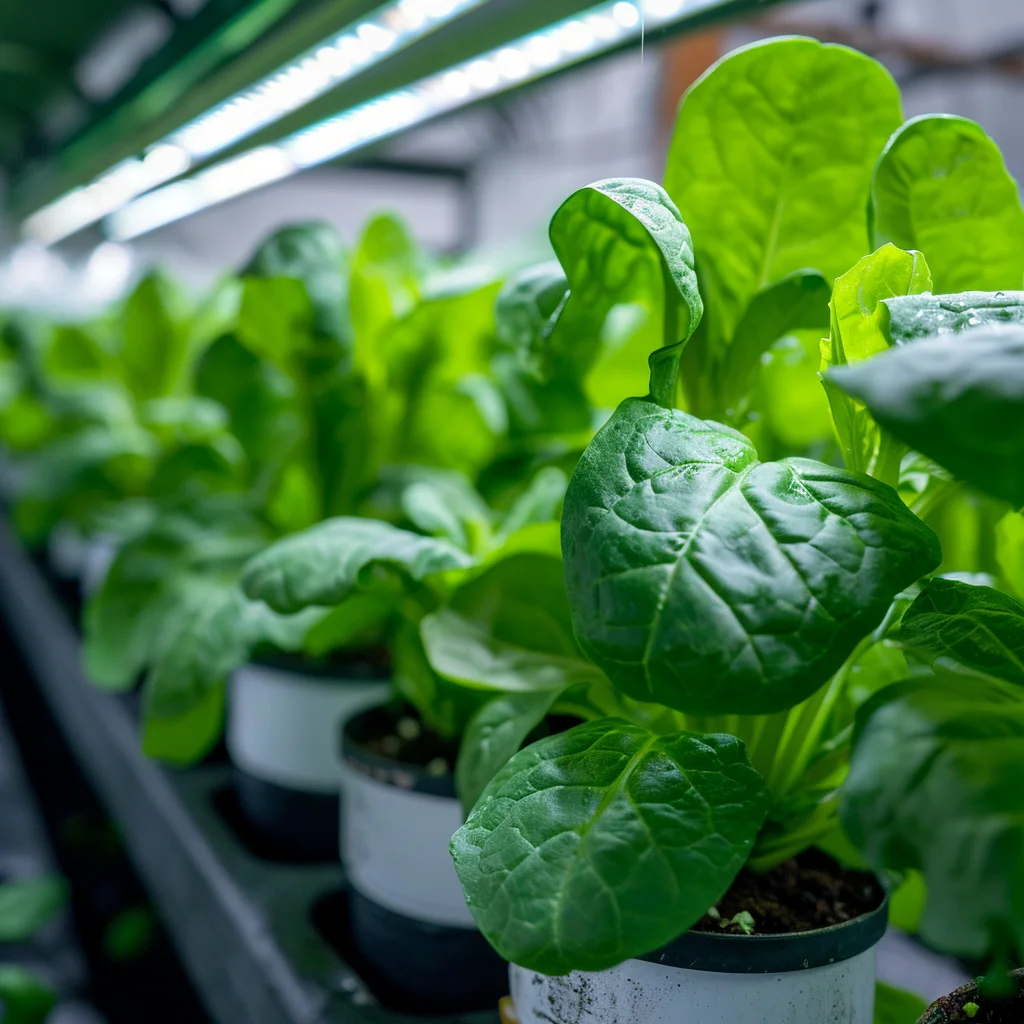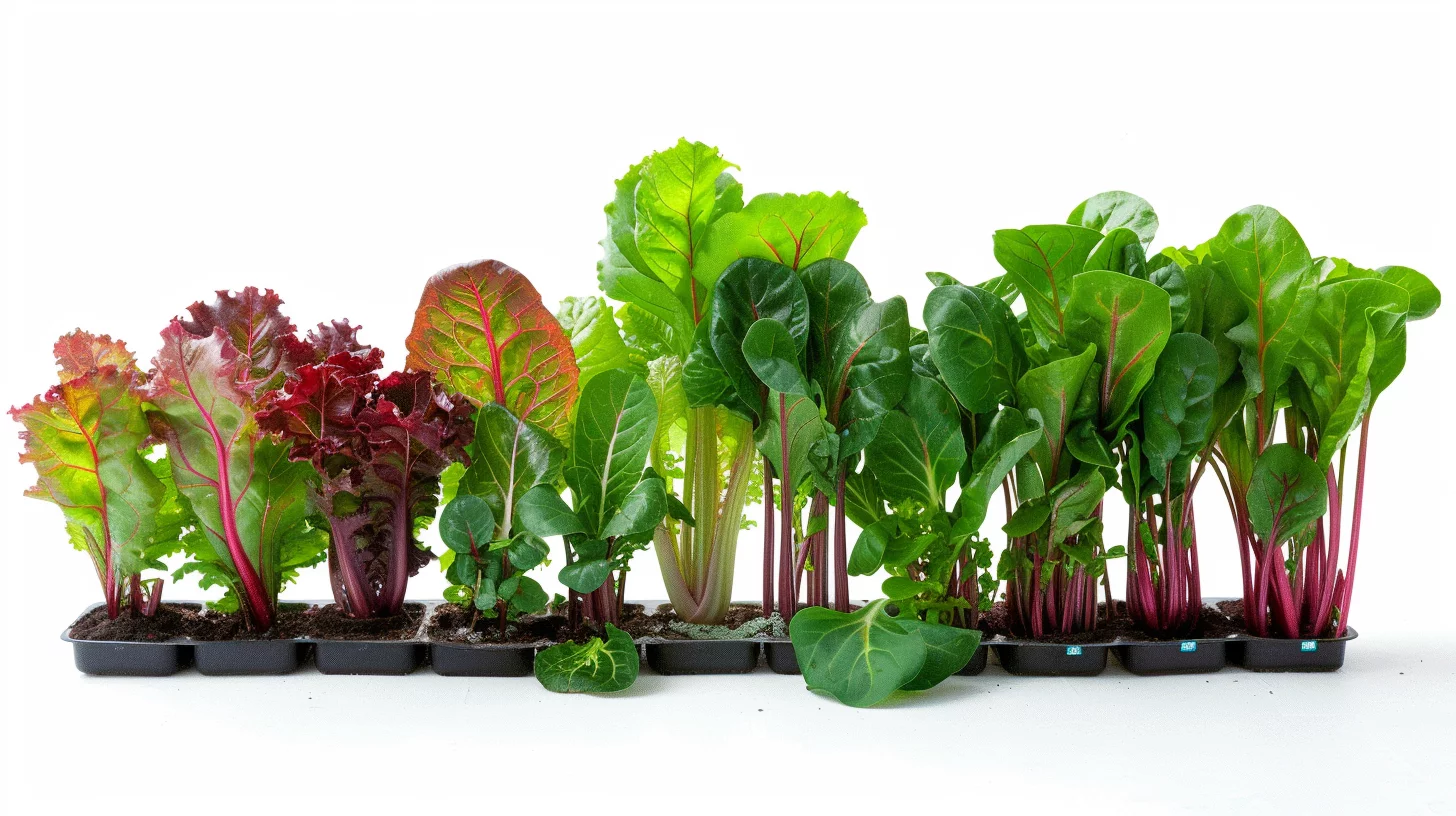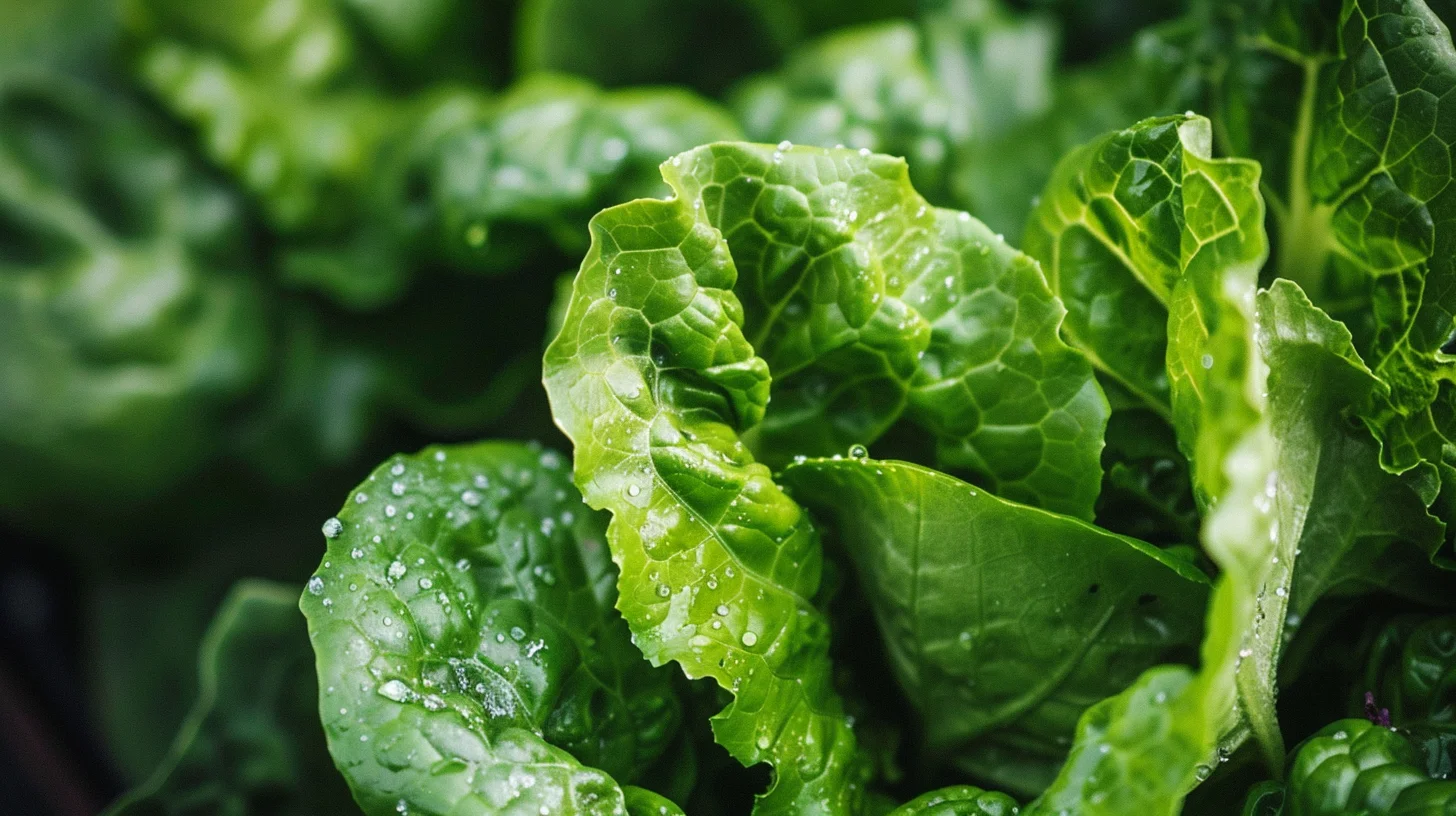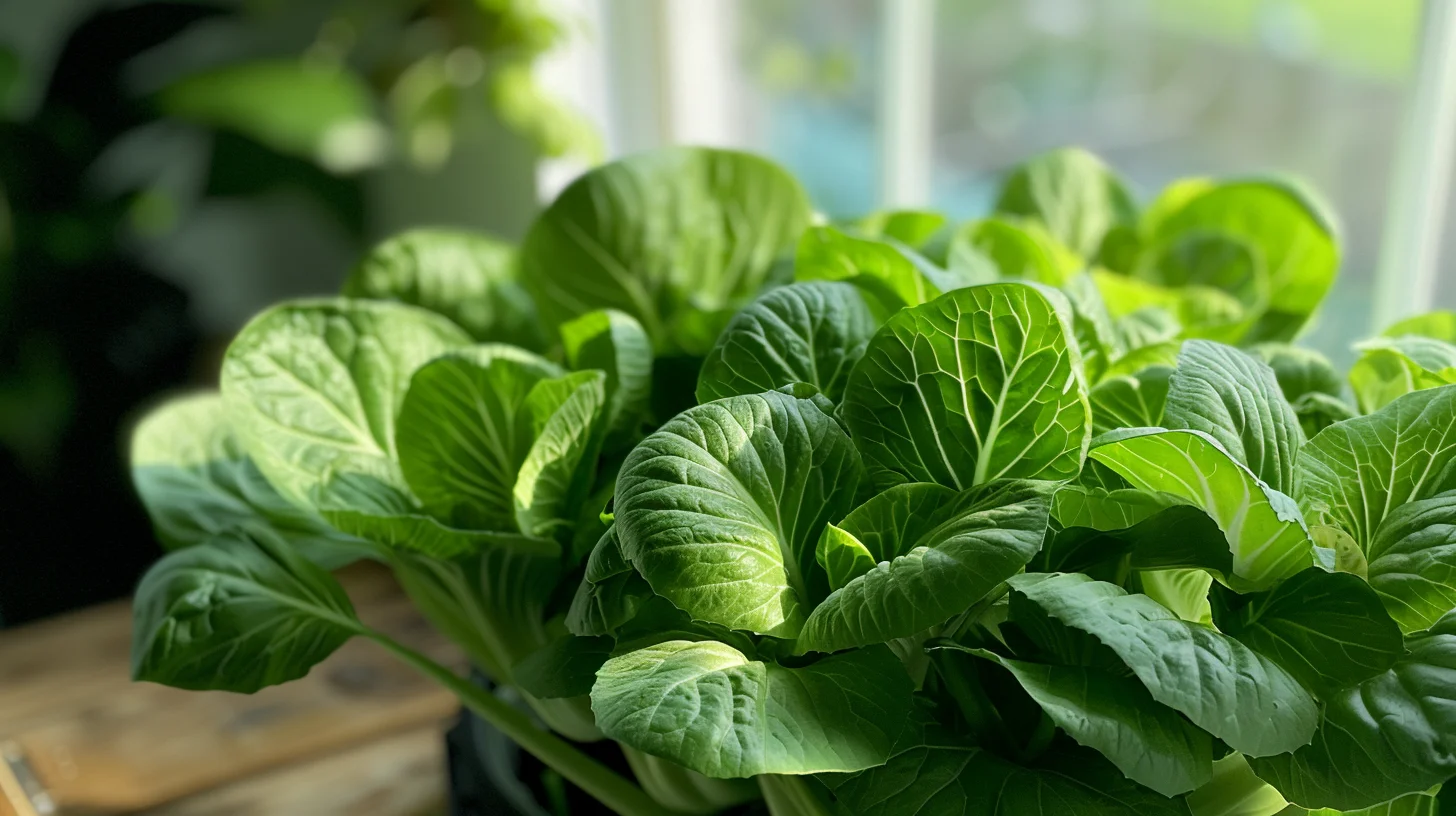Table of Contents
Introduction
Hydroponics has been gaining popularity among home gardeners as an efficient way to grow vegetables and herbs indoors year-round. By growing plants in nutrient-rich water rather than soil, hydroponics allows for faster growth, higher yields, and better control over growing conditions. And you might be wondering too can i grow spinach hydroponically?
One of the best candidates for hydroponic cultivation is spinach. This super-healthy and versatile leafy green thrives in a hydroponic system, producing crisp, tender baby spinach leaves that can be harvested multiple times in quick succession. In this comprehensive blog post, we’ll look at the many benefits of growing spinach hydroponically and provide a detailed step-by-step guide to get you started.
Growing spinach hydroponically has many advantages over traditional soil cultivation:
- Higher yields: A hydroponic spinach system can provide up to 5-6 harvests per year, compared to 2-3 harvests typically seen in soil. You can get much higher total yields from the same space.
- Faster growth: Spinach grows rapidly in the optimal conditions of a hydroponic system, shaving days or even weeks off its growth rate. You can expect baby leaves ready for harvest in as little as 3-4 weeks.
- Controlled environment: With hydroponics, you control nutrition levels, light exposure, temperature, humidity and other factors to optimize spinach growth. This results in healthier, better-tasting, and more abundant harvests.
- No soil-borne diseases: Hydroponic culture avoids soil-borne diseases like fusarium wilt, providing reliably healthy and robust spinach crops.
- Conserve water: Hydroponics uses up to 90% less water compared to conventional soil farming. It’s an incredibly water-efficient method for growing leafy greens.
- Grow year-round: Maintain ideal growing conditions indoors no matter the weather or season outside. Enjoy fresh spinach all year round.
Let’s dive into the details on how to get started with hydroponic spinach.
What is Hydroponics?
Hydroponics is a method of growing plants without soil, using mineral nutrient solutions in water. The plant roots are supported using inert growing media like perlite, clay pebbles, coconut coir or rockwool. These provide anchor points for the roots but no actual nutrients.
Instead, essential macro and micronutrients are dissolved into the water in the form of concentrated hydroponic fertilizers. This nutrient-rich solution bathes the plant roots, delivering everything the plants need to thrive. No soil is required.
There are several main types of hydroponic systems:
- Deep Water Culture (DWC) – Plants grown in buckets, totes or reservoirs with roots suspended directly in the aerated nutrient solution.
- NFT (Nutrient Film Technique) – Roots are exposed to a shallow, recirculating stream of nutrient solution.
- Drip Systems – Nutrients delivered directly to roots via drippers or sprayers.
- Wick Systems – Nutrients wicked to roots via capillary action through an absorbent growing media.
- Raft Systems – Plants placed in holes in polystyrene rafts floating on nutrient reservoirs.
- Aeroponics – Roots are misted with a nutrient spray inside a closed system.
Hydroponics allows for excellent control over the plant’s optimal growing environment. With the right lighting, temperature, nutrients and humidity levels – plants can thrive, producing higher yields in less time compared to soil.
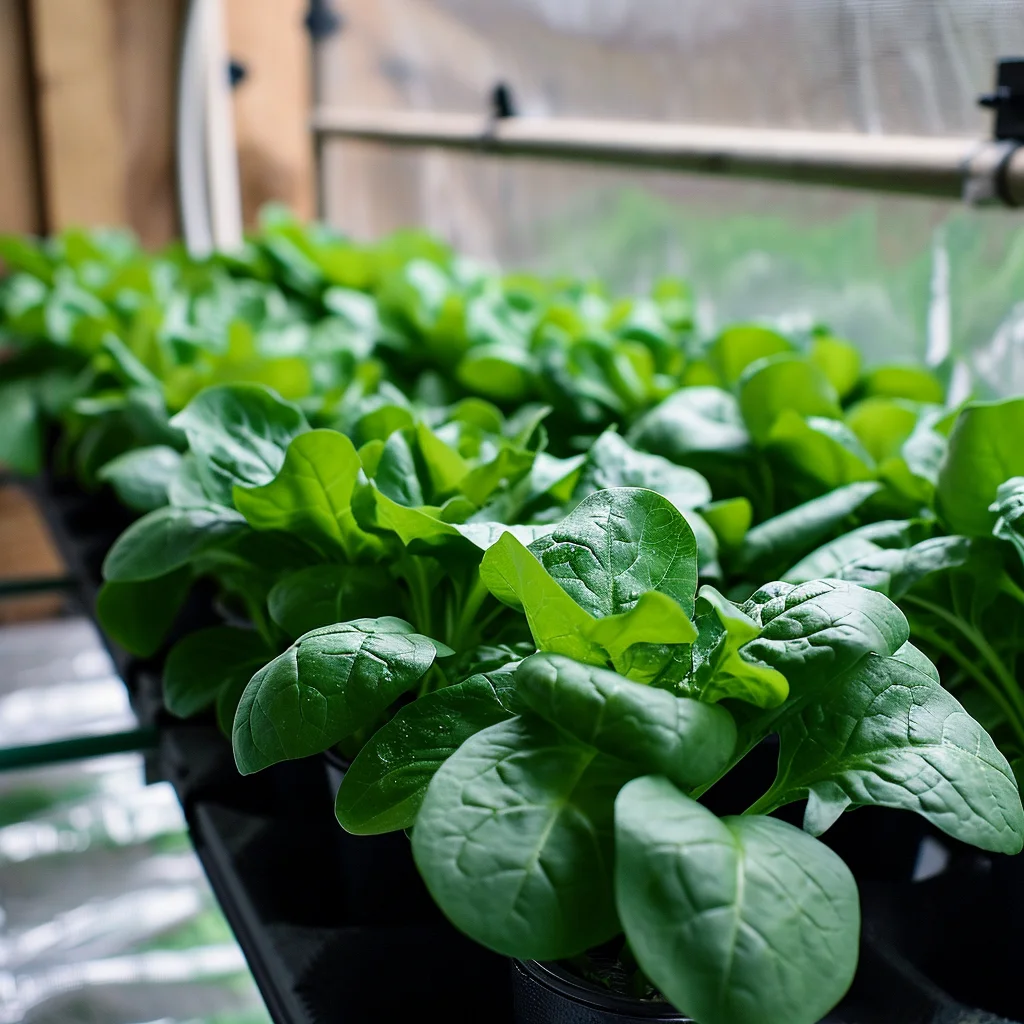
Why Grow Spinach Hydroponically?
There are several compelling reasons spinach is an ideal candidate for hydroponic cultivation:
Faster growth and year-round production
In a hydroponic system, spinach grows significantly faster than it would in soil. Growth rates can be accelerated by up to 30% or more. You can expect baby spinach leaves ready for harvest in just 3-4 weeks after germinating seeds.
This rapid growth makes year-round production achievable. You can grow fresh spinach indoors in a climate-controlled environment regardless of the season or outdoor conditions. Maintain ideal temperatures, light levels and nutrients to keep producing spinach continuously.
Higher total yields
The controlled optimal conditions in a hydroponic system drive higher yields from spinach plants. You can expect up to 4-6 harvests per plant versus just 2-3 harvests from soil spinach. Fast growth and close spacing are key.
Higher total yields are possible from the same grow space when using hydroponics compared to soil. For a small indoor setup, yields of 1-2 lbs per 10 sq. ft. are realistic. With larger systems, you can scale up substantially.
Improved taste and texture
Hydroponically grown spinach has a sweeter, more intense, concentrated spinach flavor. The texture of the leaves is also tender and crisp without the grittiness you sometimes find in soil-grown spinach.
By controlling light and nutrients, hydroponic spinach leaves grow rapidly with less time to become fibrous. This results in a more delicate, mellow tasting product.
No soil-borne diseases
Growing in a sterile hydroponic environment avoids many of the fungal diseases that plague soil-grown spinach crops. Diseases like fusarium wilt, rhizoctonia, verticillium wilt and others are not an issue.
You can grow healthy, clean spinach without needing to rotate crops or use any pesticides. Hydroponics provides reliably robust spinach plants resistant to common diseases.
Conserves water and space
Hydroponics require just 10% of the water needed for soil farming. The closed-loop recirculating systems are very water efficient, especially compared to overhead irrigation.
The ability to grow vertically with hydroponic systems also means you can maximize yield per square foot. Less space is needed to produce the same quantities of spinach compared to conventional methods.
Getting Started With a Hydroponic Spinach System
Getting up and running with hydroponic spinach is straightforward, but does require a few key components:
Reservoir – This stores the hydroponic nutrient solution. Use food-grade plastic buckets, totes or tanks. Ensure it’s completely opaque to prevent algae growth.
Growing medium – Inert media like rockwool, perlite, vermiculite or coconut coir to support roots. Avoid soil.
Nutrient solution – Use specialized hydroponic formulas that provide all the essential nutrients spinach plants need.
Submersible pump – Required to circulate the nutrient solution from the reservoir to the plants as needed.
Grow lights – Full spectrum LED grow lights provide the high intensity light spinach needs to thrive.
Air pump & stones– Important to oxygenate the nutrient reservoir. Healthy roots require dissolved oxygen.
Seedling trays, net pots – To germinate seeds and transplant seedlings into the hydro system.
pH and EC meters – Monitors your pH and electrical conductivity (nutrient levels).
There are many options when choosing an actual hydroponic system setup and equipment. For example, a simple 5-gallon bucket Deep Water Culture (DWC) or Nutrient Film Technique (NFT) system would both work very well for growing spinach. Raft systems are also suitable.
Experiment with different hydroponic techniques to see what works best for your environment. Many different configurations can grow productive hydroponic spinach.
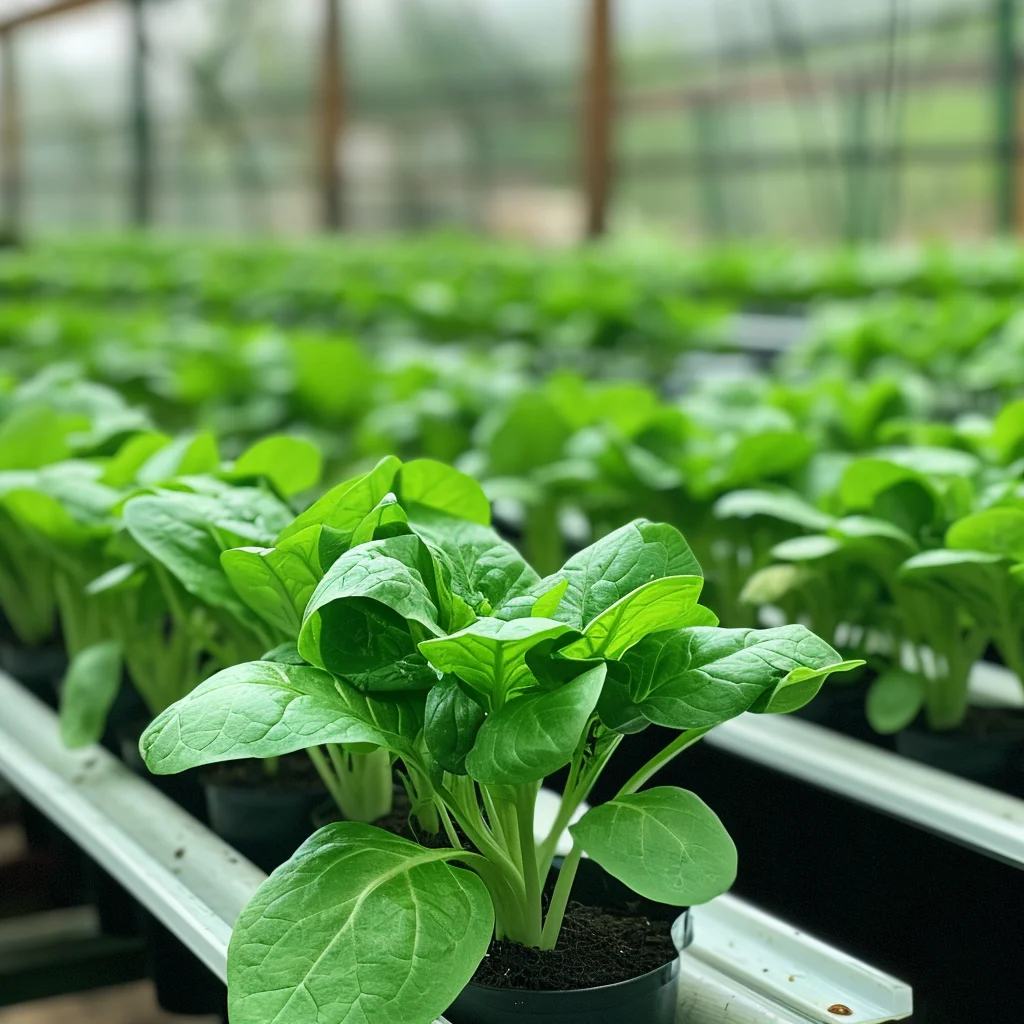
Growing Spinach Hydroponically Step-by-Step
Here is a complete step-by-step guide to growing hydroponic spinach from start to finish:
1. Select Varieties
Look for spinach cultivars well-suited to hydroponic culture. Good options include hybrid baby leaf types like ‘Tyee’, ‘Space’, ‘Regiment’, or ‘Corvair’. Mature varieties like ‘Giant Nobel’ also work well.
2. Germinate Seeds
Plant seeds in seedling starter trays filled with a sterile medium like rockwool, vermiculite or coconut coir. Maintain warm temperatures around 75°F until sprouting, usually within 3-5 days.
3. Transplant into System
When seedlings have developed their first 2-3 true leaves, transplant them into the hydroponic growing system. Gently place their net pots into the grow medium, clay pebbles work well to support stems.
4. Dial In Nutrient Solutions
Use a complete hydroponic nutrient formula suitable for leafy greens. EC levels should start around 1.2-1.4 for seedlings, increasing to 1.8-2.2 for mature plants. Maintain pH between 5.8 and 6.2 for optimal uptake.
5. Provide Proper Lighting
Spinach requires 12-16 hours per day of bright light at intensities of 300-500 μmol/m2/s. Full spectrum LED grow lights work well. Keep lights as close as possible without burning leaves.
6. Control Environmental Conditions
Ideal growing temperatures for spinach are 65-75°F. Cooler overnight temperatures can help promote leaf color. Aim for 40-70% relative humidity and good air circulation.
7. Care & Maintenance
Check pH and EC levels in the reservoir at least weekly. Top off with fresh nutrient solution as needed. Prune older growth or crowded leaves to promote new growth. Sanitize equipment and wash hands before handling to prevent diseases.
8. Initiate Harvesting
Begin harvesting baby leaves once they reach 3-4 inches long, typically 3-4 weeks after transplanting seedlings. Cut just above the base of the leaf stem a few leaves per plant.
9. Successive Harvesting
New leaves will rapidly regrow after each harvest. Continue cutting older leaves every 7-14 days. Leaf size may decrease slightly with subsequent harvests.
10. Change Reservoir
Drain and replace the entire nutrient reservoir every 2-3 weeks. Discard old roots and media as plants decline. Sanitize the system between plantings.
11. Fill Gaps as Needed
Leaf production will eventually decline. Fill any gaps with new seedlings to maintain full production. Stagger plantings to ensure consistent harvests.
Maximizing Growth, Yield and Shelf Life
Here are some additional pro tips and techniques for getting the most out of a hydroponic spinach operation:
- Use vertical growing methods like grow towers or stacked racks to multiply planting space and yields.
- Introduce CO2 enrichment up to 1500 ppm into the grow area to boost photosynthesis and growth rates.
- Consider top-down irrigation like aeroponics or fog systems for faster growth compared to deep water culture.
- Allow daytime growing temperatures to reach up to 80°F once plants are established for optimal growth.
- Avoid excessive heat or temps below 55°F which can trigger bolting (flowering) in spinach.
- Maximize light exposure by pruning lower leaves, using reflective surfaces, and moving lights closer.
- Practice excellent sanitation between plantings to prevent disease issues in the system and nutrient reservoir.
- Rinse harvested leaves in cool clean water to maintain shelf life and appeal. Pat dry before storage.
- Optimal storage is at 32 – 35°F with 95%+ relative humidity, spun leaves can last 2+ weeks.
Expanding Your Hydroponic Greens Production
Once you perfect hydroponic spinach, consider expanding with other popular leafy greens like:
- Lettuces – Green leaf, red leaf, oakleaf, romaine all grow well hydroponically.
- Kale – Dinosaur and lacinato (toscano) kale produce heavily.
- Chard – Bright lights and crimson reds add color diversity.
- Arugula – Spicy greens grow rapidly hydroponically.
- Basil – Flavorful and aromatic addition to any setup.
The same systems and techniques used for spinach translate directly to growing other greens hydroponically. Maximize your space and enjoy diversity in your harvests!
Conclusion
Growing delicious, nutrient-dense spinach is easy with hydroponic methods. You can enjoy year-round indoor harvests of tender baby spinach greens. Hydroponics allows for excellent control over the growing environment and higher yields of spinach in less time.
With this comprehensive guide, you now understand everything needed to get your own productive hydroponic spinach operation up and running. Start small then expand your system as you like. Growing hydroponic spinach is a fun, rewarding way to produce your own fresh greens year-round. The superior flavor and texture make home-grown hydroponic spinach well worth the effort!
